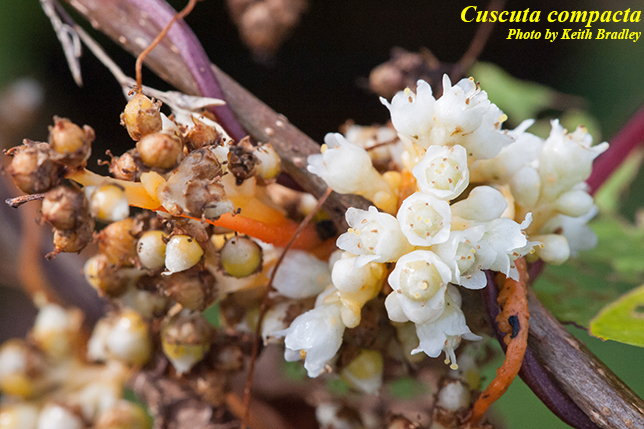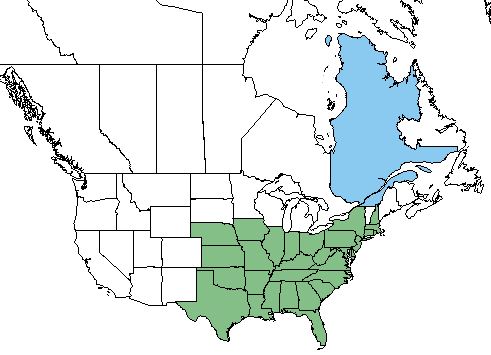Cuscuta compacta
| Cuscuta compacta | |
|---|---|

| |
| Photo by the Atlas of Florida Plants Database | |
| Scientific classification | |
| Kingdom: | Plantae |
| Division: | Magnoliophyta - Flowering plants |
| Class: | Magnoliopsida - Dicots |
| Order: | Solanales |
| Family: | Cuscutaceae |
| Genus: | Cuscuta |
| Species: | C. compacta |
| Binomial name | |
| Cuscuta compacta Juss | |

| |
| Natural range of Cuscuta compacta from USDA NRCS Plants Database. | |
Common Name: compact dodder[1][2]
Contents
Taxonomic Notes
Varieties: C. compacta var. compacta; C. compacta var. efimbriata[1][2]
Description
Distribution
C. compacta occurs from Nebraska, south to Texas, eastward to central peninsular Florida, and northward to Illinois, New York, and New Hampshire.[1][2] It has also been introduced in Quebec Canada.[2]
Ecology
Habitat
C. compacta is found on herbaceous and woody hosts in bottomland forests, stream banks, marshes, swamps, pine savannahs, wet fields, and other wet habitats.[1]
Phenology
In the southern and mid-Atlantic United States, C. compacta flowers from late July through November.[1][3]
Use by animals
Pawnee Indians would use C. compacta to dye materials, such as feathers, orange. Maidens of the Pawnee would also use the parasite for divination to determine if their suitors sincerely loved them. A Mexican Indian has reported that rattlesnakes would take this plant into their dens for food.[4]
Conservation and Management
Cultivation and restoration
Photo Gallery
References and notes
- ↑ 1.0 1.1 1.2 1.3 1.4 Weakley AS (2015) Flora of the Southern and Mid-Atlantic States. Chapel Hill, NC: University of North Carolina Herbarium.
- ↑ 2.0 2.1 2.2 2.3 USDA NRCS (2016) The PLANTS Database (http://plants.usda.gov, 24 January 2018). National Plant Data Team, Greensboro, NC 27401-4901 USA.
- ↑ Nelson G (24 January 2018) PanFlora. Retrieved from gilnelson.com/PanFlora/
- ↑ Gilmore MR (1919) Uses of plants by the indians of the Missouri river region. Smithsonian Institution, Bureau of American Ethnology, Annual Report 33.